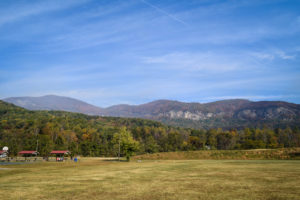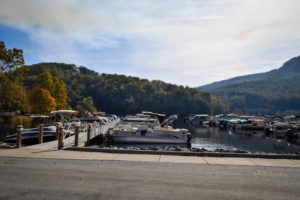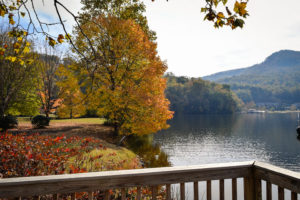By Maggy McGloin – 2016
Moving from the Western part of the state, the drive to Lake Lure brings Highway 64 through a more natural, unchartered territory. After weaving around winding turns,  across abandoned-looking towns, and several fruit stands, you will see the scen e emerge from around the bend: the infamous Lake Lure, zig-zagging around rugged mountain ranges.
across abandoned-looking towns, and several fruit stands, you will see the scen e emerge from around the bend: the infamous Lake Lure, zig-zagging around rugged mountain ranges.
You can arrive to the lake through the entrance to Morse Park. The wide parking lot, just left of the lake, is speckled with few cars, so you can anticipate a quiet walk through the earthy landscape, uninterrupted by too many picnics or noisy frisbee-throwers. Get out of the car–leave your phone inside–and breathe in the crisp, autumn air. Take a walk through Lake Lure’s public garden, passing couples holding hands and babies in strollers–caught in the aura of simple contentedness. An aerial view of the lake exposes a quiet gazebo in the distance that looks out to one of the most beautiful views along Highway 64. The contrast between the mountains and lake may remind you of the changing North Carolina landscape along Highway 64, shifting between the coastal plains, foothills, and mountains.
Lake Lure’s public garden, passing couples holding hands and babies in strollers–caught in the aura of simple contentedness. An aerial view of the lake exposes a quiet gazebo in the distance that looks out to one of the most beautiful views along Highway 64. The contrast between the mountains and lake may remind you of the changing North Carolina landscape along Highway 64, shifting between the coastal plains, foothills, and mountains.
Begin a silent, meditative walk along the perimeter of t he lake. Rather than imagining yourself on the set of Dirty Dancing, a film inspired by this place, focus on the foliage around you, the memorial benches and species labeled along the path. It’s time to relax amongst the orange-browns and reds before you return back to work or school, the crisp air channeled through the leaves and your lungs, one of the same breath.
he lake. Rather than imagining yourself on the set of Dirty Dancing, a film inspired by this place, focus on the foliage around you, the memorial benches and species labeled along the path. It’s time to relax amongst the orange-browns and reds before you return back to work or school, the crisp air channeled through the leaves and your lungs, one of the same breath.
After about thirty minutes, circle back from your meditation walk, headed back to the parking lot where you’d abandoned the car, technology, and the outside world. Returning to the road is sad, but you can be grateful for the time spent i n nature. Perhaps take one last look back at the mountains, soon to return behind you. A pillow of smoke catches your eye, curling from the top of the mountain in a small patch. Must be a small forest fire, you think at the time; snap a few photos and go on your way. Weeks later, you may think back and realize that this small cloud of smoke could have grown to become one of the most destructive forest fires in North Carolina, spreading to Asheville and uncontainable until December 7, 2016.
n nature. Perhaps take one last look back at the mountains, soon to return behind you. A pillow of smoke catches your eye, curling from the top of the mountain in a small patch. Must be a small forest fire, you think at the time; snap a few photos and go on your way. Weeks later, you may think back and realize that this small cloud of smoke could have grown to become one of the most destructive forest fires in North Carolina, spreading to Asheville and uncontainable until December 7, 2016.
